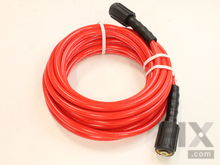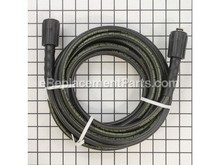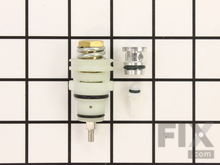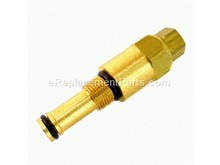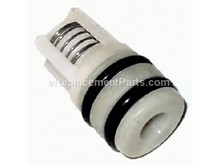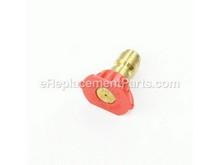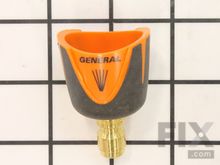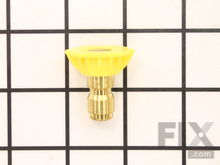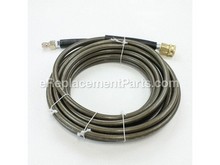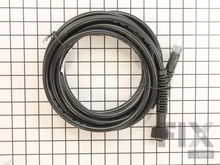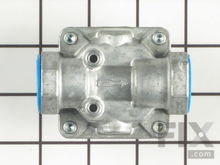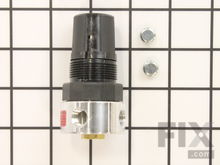Common Pressure-Washer Parts To Fix "No Or Low Pressure"
- Rated as REALLY EASY
- 5 step by step videos
Hose
If your power washer is not spraying water at high pressure, the first and most obvious thing to check is the water supply going into the machine. Most washers require a continuous water supply of about 4L per minute to operate normally. Many pressure washer manufacturers recommend using a ¾” diameter hose instead of the much more common 5/8” diameter hose to supply water to the pressure washer. Check for any kinks or blockages in your hose. If there are none, detach the hose from the inlet valve on the washer and check to see if the water output is sufficient and that there is no debris caught in the inlet filter screen that may be restricting the flow of water into the washer. Some water sources, like a well, can vary in their output over long periods of time. It is important to ensure that the water supply going into the washer is sufficient before moving on to investigate any problems internal to the power washer.
Unloader Valve
The unloader valves main function is to divert the flow of water in the pump into bypass when water is not being sprayed from the nozzle. The unloader valve can also be adjusted to increase or decrease the pressure of water coming out of the nozzle. The exact process to increase or decrease pressure will depend on the type of unloader you have (flow-actuated or pressure-actuated). If you are experiencing a gradual loss of pressure in your machine, check to see if the nozzles on the trigger-wand are worn and need to be replaced first before adjusting the unloader valve. Adjustment of the unloader valve should be done in small increments to prevent pressure from building too high. It is also recommended to attach a pressure gauge to the unloader when adjusting so you are able to monitor the changes in pressure and keep it within a safe range for operation. This is a delicate adjustment that can cause damage to the unloader and related components if performed unnecessarily or improperly. It is important to check other related components if experiencing issues with low water pressure first before adjusting the unloader valve to increase the flow of water. The unloader valve should always be adjusted with the machine running and the trigger wand pulled, so water is allowed to flow through the system. If adjustments to the unloader valve do not normalize the water pressure, the unloader valve may be broken and in need of repair or replacing.
Nozzles
A common cause for lost water pressure is when the nozzle at the end of the trigger-wand becomes worn or plugged. An uncommon spray pattern may be an indication that there is debris blocking the nozzle. Nozzles that are wearing will usually cause a gradual loss in pressure, as opposed to happening suddenly. This is due to the holes in them that release the water widening over time. As the hole widens and more water is able to flow through, water pressure is lost. Nozzles will wear over time with regular use, and will need to be replaced. It is helpful to have a number of properly functioning nozzles on hand. This will allow you to easily change out nozzles and control the pressure of the water being expelled, and to quickly test to see if a worn nozzle is causing a pressure-related problem, or if the issue is being caused by the pump or water intake.
High Pressure Hose
If you have recently replaced the high pressure hose on your unit and are noticing a loss in pressure, you may have installed an incorrect hose that is wider than required for your model of washer. Hoses typically come in three widths; 1/4”, 5/16” & 3/8”. When replacing the hose on your washer, make sure you buy a hose with the exact same diameter. The diameter of the hoses can look similar, but an extra fraction of an inch can cause a very noticeable loss of pressure during operation. If you are unsure of the proper width of hose for your machine, consult your user manual.
Pressure Regulator
Some power washers may be equipped with a pressure regulator system in place of an unloader valve. The two serve the same purpose but function differently. An unloader valve has a mechanism in place to ‘trap’ pressure between itself and the nozzle, which relieves the pump of withstanding any back-pressure created when the trigger-wand is released and the flow of water is stopped. A regulator performs the same task of keeping the pressure and redirecting water flow, but does not stop back flow into the pump. Over time, this can cause problems with the pump, making an unloader the preferable mechanism to have installed. If your washer is losing water pressure and has a regulator installed, the regulator may need to be adjusted to allow more water to flow through it. It may also be worn and losing its ability to keep the water under pressure, in which case it should be replaced altogether.
More Repair Parts
Still not sure which part is broken? We can offer you custom troubleshooting help if you search with your model number.






